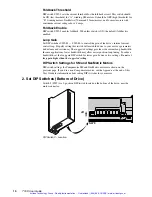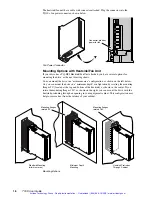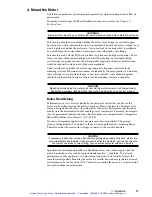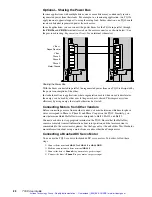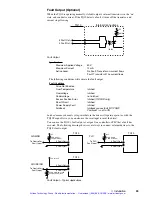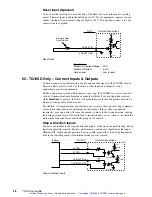
18
TQ10 User Guide
5. Connect the Motor to the Drive
The TQ10 Drive works with three-phase brushless motors equipped with Hall effect
sensors. The typical motor has a permanent-magnet rotor with four poles (two pole pairs).
Higher pole-count motors may also be used.
In the following installation procedure, we assume you are using a Compumotor SM or
NeoMetric Series Motor with your TQ10 Drive. If you are using a non-Compumotor
motor, consult the
Appendix
at the end of this User Guide for information you may need
during the following installation steps.
Connect Hall Effect Wires
The TQ10 Drive is designed to be used with motors that have single-ended, open collector
Hall outputs. Internally, the drive pulls these signals up to +15V.
For best performance and reliability, the drive should be used with motors having no more
than six electrical degrees of commutation error in either direction. Motors with greater
commutation error may cause increased torque ripple and motor heating, reduced average
torque, and greater stresses on the drive output stage.
Connect your motor’s Hall effect wires to the 10-pin screw terminal on the front of the
TQ10. Each terminal is labeled with the name of the wire you should connect.
Compumotor
4
5
6
7
8
9
10
HALL GND
HALL +5V
HALL 1
HALL 2
HALL 3
MOTOR TEMP +
MOTOR TEMP -
Hall Effect and Motor Temperature Connections – Front of Drive
14 AWG (2.5 mm
2
) is the maximum wire size that can fit in the connector.
Connect Motor Thermostat Wires
Connect your motor’s thermostat wires to
MOTOR TEMP+
and
MOTOR TEMP-
.
If your motor does not have a thermostat, short
MOTOR TEMP+
and
MOTOR TEMP-
together by connecting an insulated jumper wire between them. The drive will experience
a motor fault if neither a thermostat nor a jumper wire is attached to the
MOTOR TEMP
terminals.
WARNING
Hazardous voltages are present on
MOTOR TEMP+
and
MOTOR TEMP–
when the drive
is powered up. Use insulated wires for connections. Protect personnel from contacting
these terminals or any attached wires. Do not short these terminals to earth ground.
The TQ10’s motor overtemperature fault can, in many cases, protect the motor against
overheating. Through its
MOTOR TEMP+
and
MOTOR TEMP-
terminals, the drive checks
for electrical continuity provided by a normally-closed thermostat mounted on the motor.
If the motor overheats and the thermostat opens, the loss of continuity triggers protection
circuitry in the TQ10. It will turn off power output to the motor, and illuminate the LED
labeled
MOTOR FAULT
.
This is a latched fault. Wait for the motor to cool, then cycle power to resume operations
(with the TQ10 Torque Drive, you can also toggle the reset input to resume operations). A
motor overtemperature fault indicates improper motor sizing, or improper installation of
your application.
Artisan Technology Group - Quality Instrumentation ... Guaranteed | (888) 88-SOURCE | www.artisantg.com







